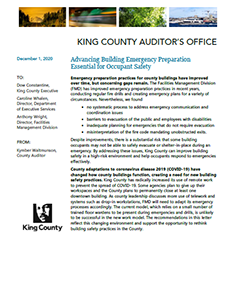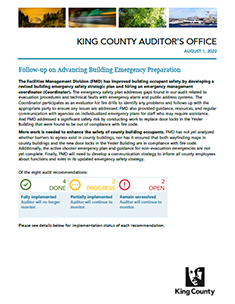Advancing Building Emergency Preparation Essential for Occupant Safety
December 1, 2020
NEW! Download the latest follow-up report
Emergency preparation practices for county buildings have improved over time, but concerning gaps remain. Changing uses of county buildings provide both challenges and opportunities for ensuring the safety of building occupants in the future. We found:
- lack of a systematic process to address emergency communication and coordination issues
- barriers to evacuation of the public and employees with disabilities
- inadequate planning for emergencies that do not require evacuation
- misinterpretation of the fire code mandating unobstructed exits.
By addressing these issues and adapting to changing uses of county buildings, King County can improve building safety in a high-risk environment and help occupants respond to emergencies effectively.
This document was updated on Dec 31, 2020, to include the section "Misinterpretation of the Fire Code Mandating Unobstructed Exits" which was inadvertently excluded from the original publication.
Status
Of the eight recommendations:
| DONE | 4 | Recommendations have been fully implemented. Auditor will no longer monitor. |
|---|---|---|
| PROGRESS | 2 | Recommendations are in progress or partially implemented. Auditor will continue to monitor. |
| OPEN | 2 | Recommendations remain unresolved. Auditor will continue to monitor. |
| CLOSED | 0 | Recommendation is no longer applicable. Auditor will no longer monitor. |
Summary
Despite recent improvements by the Facilities Management Division, there is a substantial risk that some building occupants may not be able to safely evacuate or shelter-in-place during an emergency. We found no systematic process to address emergency communication and coordination issues, barriers to evacuation of the public and employees with disabilities, inadequate planning for emergencies that do not require evacuation, and misinterpretation of the fire code mandating unobstructed exits.
We recommend that the Facilities Management Division update its processes for ensuring the safety of building occupants during emergency to reflect changes in county building use, to incorporate emergencies that do not require evacuation, and to ensure that issues observed during routine processes are identified and addressed. We also recommend that the King County Executive ensure that they are individualized plans for staff who are unable to evacuate independently and that the Facilities Management Division ensure that public wayfinding maps are accurate and that all locked doors in the path of egress are compliant with the Seattle Fire Code.
Reports related to this audit
Currently, there are no related reports to this project.
Audit team
Laina Poon, Kayvon Zadeh, and Brian Crist conducted this audit. If you have any questions or would like more information, please call the King County Auditor's Office at 206-477-1033 or contact us by email at KCAO@kingcounty.gov.

 Translate
Translate

